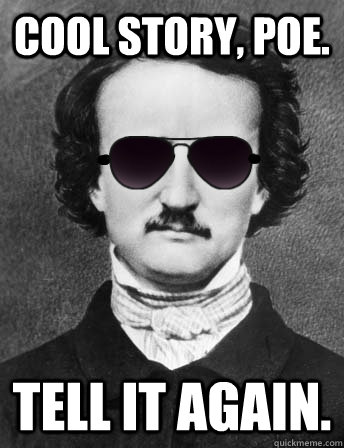Despite what your grade-school teacher might have told you, poetry isn’t all hearts and flowers, especially not when you have to analyze a poem in an essay. When you delve into the realm of poetry, you’re much more likely to stumble into madness and decay, especially if you are reading Edgar Allen Poe or Charles Bukowski!
Mwahahahaha…ha…ha.
Okay, I’m exaggerating (a little). Poetry can be fun. And full of puns. Like this one.
Regardless, don’t lose your head just yet–I have some tips on how to analyze a poem in a way that doesn’t bring doom and gloom to your grades.
Choosing a Poem to Analyze
The vast majority of the time, your instructor will tell you which poem to analyze. However, on the off chance that you have to choose a poem yourself, choosing the right poem can make learning how to analyze a poem much, much easier.
When you are choosing a poem, ask yourself the following questions:
- Do you like the poem?
- Do you have notes from class that could help you start your essay?
- Do you understand the language in the poem?
- Could you summarize the poem in your own words?
- Are there resources online that you could use to understand the poem better?
- Does the poem have obvious literary elements (rhyme, meter, metaphor, etc.)?
If you answered “yes” to many of those questions, then the poem you have will likely work great for your analysis.
What Is a Poetry Analysis?
Before you can really start writing your analysis, you need to know what your instructor expects of you. A poem analysis is much like any other literary analysis, but it caters more specifically to poems. For instance, since poems are typically short, the analyses are also often short. Few instructors will make you write a poetry analysis for more than about 3-5 pages. Whew!
However, the shorter length doesn’t let you off the hook. With your poetry analysis, you need to focus on two main aspects of the poem you choose: theme and the literary elements that proves that theme. Your thesis statement needs to contain both of those aspects, and you’ll spend your body paragraphs discussing examples of the literary elements and how they relate back to the theme.
Now, let’s get into more detail.
Summarizing and Paraphrasing a Poem
Learning how to analyze a poem gets a lot simpler when you start by summarizing or paraphrasing the poem and figuring out what the heck the poet is even talking about. I’m going to use “Desert Places” by Robert Frost to help you understand what I mean.
(And, no, I will not use “The Road Not Taken”! Frost did write other poems, people!)
Here’s “Desert Places” in case you aren’t familiar with it:
Snow falling and night falling fast, oh, fast
In a field I looked into going past,
And the ground almost covered smooth in snow,
But a few weeds and stubble showing last.
The woods around it have it – it is theirs.
All animals are smothered in their lairs.
I am too absent-spirited to count;
The loneliness includes me unawares.
And lonely as it is, that loneliness
Will be more lonely ere it will be less –
A blanker whiteness of benighted snow
WIth no expression, nothing to express.
They cannot scare me with their empty spaces
Between stars – on stars where no human race is.
I have it in me so much nearer home
To scare myself with my own desert places. (Frost)
MLA Citation
Frost, Robert, and Robert Hunter. “Desert Places.” Poemhunter.com. Web. 30 June 2015.
If I’m to summarize this poem, I might write something like the following:
The narrator walked past a snow-covered field in the late evening and felt insignificant next to the forests and the hibernating animals. The narrator becomes lonely and expects to become lonelier. As the narrator looks up at the stars, he or she realizes that nothing could feel as empty as he or she feels inside.
Note that you would not use the above summary in an essay. However, putting a poem in your own words can really help you understand the feeling of the poem and what the author is trying to convey.
If you wanted to go further in depth with your understanding, you could paraphrase the poem, which basically means rewriting every line in your own words rather than condensing the information.
Choosing a Theme to Write about
Once you understand what the poem is trying to say, you need to come up with a theme. A theme is a central idea in a poem. In “Desert Places,” Frost talks a lot about loneliness, and since the narrator in the poem is alone, I can say that loneliness and isolation are main ideas or themes in the poem.
When you are searching for a theme in your poem, look for concepts or notions that seem to pop up several times. Think about the feeling the poem might be trying to convey. That will often lead you straight to the theme.
If you can’t think of a theme, you can either talk to your instructor about it or look online to see what scholars say about the themes in the poem. Resources such as Sparknotes.com can also help you get on the right track.
Choosing a Literary Device or Element
To complete your essay topic, you need to choose one or more literary elements the poem uses to point toward the theme you chose. Here are some examples of literary devices you could be looking for:
- Rhyme
- Meter
- Metaphor
- Simile
- Setting
- Allegory
- Alliteration
- Caesura
- Enjambment
- Hyperbole
- Satire
There are many more literary devices to choose from; see a longer list here. I would suggest choosing one or two devices for most essays. Make sure that you can relate them back to the theme you chose.
If I were to write a poetic analysis of “Desert Places” specifically on the topic of loneliness and isolation, I would choose rhyme as one of my literary devices.
Rather than a traditional a/a/b/b or a/b/a/b rhyme scheme for his quatrains (stanzas with four lines), Frost chose an a/a/b/a rhyme scheme. Since one of the words in each stanza does not rhyme with anything, it could be said that the poet has isolated one word in each stanza, which demonstrates the loneliness the speaker talks about in the content of the poem.
(Wow! Right?)
Mark where the literary device occurs in the poem and keep those notes for later. You can use them as examples for when you start writing your analysis.
Writing Your Thesis Statement
I’ve said it before, and I’ll say it again: having a good thesis statement means that the rest of your paper will be a breeze. Essentially, a good thesis statement becomes a one-sentence outline of your paper.
Here’s what my thesis statement for my “Desert Places” analysis might look like:
In “Desert Places,” Robert Frost uses an unusual rhyme scheme, specifically an a/a/b/a rhyme scheme, to demonstrate the narrator’s isolation and loneliness.
This would be a great thesis statement for a short poetry analysis (1-2 pages). For a longer poetry analysis (3-5 pages), you might want to choose two or three literary devices that explicate your theme.
When you write your thesis, you might find this template helpful:
In [poem’s name], [poet] employs [literary devices] to demonstrate [theme].
Here, it is important that you are specific. In my example, I made sure to specify how the rhyme scheme was unusual rather than just leaving it at that. Make sure you do the same.
For more help building out a winning thesis statement, see Kibin’s thesis statement builder!
Analyzing a Poem in Body Paragraphs
Though writing your introduction and thesis statement is certainly half the battle, you need to win your audience over with your supporting body paragraphs. Think about it this way: your head wouldn’t do you much good without all the organs and systems that comprise your body.
(Didn’t think you were going to get an anatomy lesson in a poetry post, did you?)
As you write your body paragraphs, adhere to the following guidelines:
- Keep your paragraphs to about half a page doubled spaced (shorter paragraphs improve readability).
- Start your paragraph with your topic sentence, which should relate to everything you are going to say in the paragraph (think of it as the paragraph’s thesis statement).
- Use only one piece of evidence per paragraph, either a quote or a paraphrased example from the text.
- Always end a paragraph in your own words and make sure to include analysis (why the evidence supports your thesis statement) at the end of each paragraph.
By following those guidelines, you’ll set yourself up for an essay that knocks your instructor’s socks off.
A Few More Tips on How to Analyze a Poem
Though you have learned how to analyze a poem, I haven’t really mentioned how you can sound smart doing it. Now, this doesn’t mean that you should go crazy and throw in a bunch of fancy synonyms (see How to Become a Better Writer: Don’t Use Words that Sound Smart). What it does mean is using vocabulary that is appropriate for poems.
I already gave you a list of literary terms and their definitions, which should catapult you to greatness in your analysis already, but here are some important tidbits to remember when you write a poetic analysis:
- Don’t assume that the poet and the speaker/narrator in the poem are the same person. Instead, refer to the person in the poem as “he or she” or just “the speaker” or “the narrator.”
- Don’t use words like “obviously” or “clearly” in your poetic analysis. If it were so obvious, you wouldn’t have to write an essay about it.
- Don’t spend time summarizing the poem in your essay. Assume your reader has already read the poem.
- Don’t worry too much about working through the poem line by line or in order. Use the evidence that best supports your claim in the order that makes sense for your argument.
- Don’t forget to cite your poem according to MLA formatting. Any quote you use should have an in-text citation.
Check out these examples of poetic analyses written by students like you for more inspiration and ideas.
Make Sure Your Paper Is Polished before You Turn It in!
If you are still stuck or nervous about writing your analysis, that’s okay. Sometimes, just getting something out on paper will give you the courage you need to keep going and revise what you’ve written to fit the above-mentioned guidelines.
As you’re revising, I highly recommend reading your analysis out loud. Doing so will help you find awkward or confusing areas so you can pinpoint what still needs work. You can also get a friend, family member, or professional editor to look your paper over. At Kibin, our editors are ready to polish your essay at any time of day or night.
Whether you need some advice on what you’ve written so far or want our talented editors to polish your essay into analytic gold, our editing services can help you!
Now that you know how to analyze a poem, put your skills to the test on your own essay!



